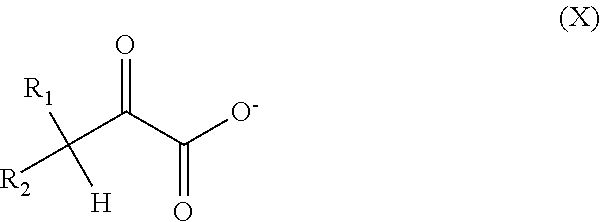Process for Treating an Underground Formation
a technology for underground formations and processes, applied in the direction of sealing/packing, building repairs, borehole/well accessories, etc., can solve the problems of affecting the operation of the underground formation, and the formation has a tendency to produce sand, etc., to achieve the effect of easy removal and difficult removal
- Summary
- Abstract
- Description
- Claims
- Application Information
AI Technical Summary
Benefits of technology
Problems solved by technology
Method used
Image
Examples
example 1
Deposition of Calcium Carbonate
[0142]A treatment fluid comprising deionised water containing 10% w / v sodium glycinate (glycine sodium salt hydrate) and 10% w / v calcium chloride dihydrate was prepared and placed in stoppered pyrex boiling tubes. The initial pH, measured at room temperature was 10.54. On heating to 60° C., a white precipitate was slowly deposited on the internal surface of the glass tube (that part of the tube in contact with the treatment fluid) over a period of 3 days. The precipitate was collected, washed and identified as calcium carbonate using FT-IR analysis. Addition of 4M hydrochloric acid to the white precipitate resulted in evolution of gas. The same treatment fluid maintained at ambient temperature (approximately 20° C.) also deposited calcium carbonate but at a much slower rate (at least 10 days).
example 2
Deposition of Calcium Carbonate
[0143]A treatment fluid comprising deionised water containing 10% w / v L-histidine with a stoichiometric amount of sodium hydroxide and 10% w / v calcium chloride dihydrate was prepared and placed in stoppered pyrex boiling tubes. On heating to 60° C., a white precipitate was slowly deposited on the internal surface of the glass tube (that part of the tube in contact with the treatment fluid) over a period of 3 days. The precipitate was collected, washed and identified as calcium carbonate using FT-IR analysis. Addition of 4M hydrochloric acid to the white precipitate resulted in evolution of gas.
example 3
Deposition of Calcium Carbonate
[0144]A treatment fluid comprising deionised water containing 10% w / v β-alanine with a stoichiometric amount of sodium hydroxide and 10% w / v calcium chloride dihydrate was prepared and placed in stoppered pyrex boiling tubes. On heating to 60° C., a white precipitate was slowly deposited on the internal surface of the glass tube (that part of the tube in contact with the treatment fluid) over a period of 3 days. The precipitate was collected, washed and identified as calcium carbonate using FT-IR analysis. Addition of 4M hydrochloric acid to the white precipitate resulted in evolution of gas.
PUM
| Property | Measurement | Unit |
|---|---|---|
| Viscosity | aaaaa | aaaaa |
| Solubility (mass) | aaaaa | aaaaa |
Abstract
Description
Claims
Application Information
 Login to View More
Login to View More - R&D
- Intellectual Property
- Life Sciences
- Materials
- Tech Scout
- Unparalleled Data Quality
- Higher Quality Content
- 60% Fewer Hallucinations
Browse by: Latest US Patents, China's latest patents, Technical Efficacy Thesaurus, Application Domain, Technology Topic, Popular Technical Reports.
© 2025 PatSnap. All rights reserved.Legal|Privacy policy|Modern Slavery Act Transparency Statement|Sitemap|About US| Contact US: help@patsnap.com


